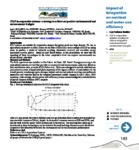Please use this identifier to cite or link to this item:
http://www.alice.cnptia.embrapa.br/alice/handle/doc/1026989| Title: | ICLF in cooperative systems: a strategy to achieve net positive environmental and socioeconomic budgets. |
| Authors: | BULLER, L. S.  BERGIER, I.   ORTEGA, E.   MORAES, A. de   |
| Affiliation: | LUZ S. BULLER, UNICAMP; IVAN BERGIER TAVARES DE LIMA, CPAP; ENRIQUE ORTEGA, UNICAMP; ANIBAL DE MORAES, UFPR. |
| Date Issued: | 2015 |
| Citation: | In: WORLD CONGRESS ON INTEGRATED CROP-LIVESTOCK-FOREST SYSTEMS; INTERNATIONAL SYMPOSIUM ON INTEGRATED CROP-LIVESTOCK SYSTEMS, 3., 2015, Brasília, DF. Towards sustainable intensification: proceedings. Brasília, DF: Embrapa, 2015. |
| Pages: | p. 185. |
| Description: | ICLF systems are suitable for cooperative designs that gather small and large farmers. We use an agricultural cooperative in Mato Grosso do Sul state as an example of ICLF INCLUDING SWINE to produce a model of nutrients recycling, stormwater recovery and renewable energy production (eletric power). Based on pilot farms studies, in this presentation we show that the upscaling of these technologies to the entire cooperative level can improve environmental and socioeconomic indicators. |
| Thesagro: | Tecnologia Cooperativa de produtores |
| NAL Thesaurus: | Technology Cooperatives |
| Keywords: | Nutrients recycling Renewable energy production Stormwater recovery |
| Type of Material: | Resumo em anais e proceedings |
| Access: | openAccess |
| Appears in Collections: | Resumo em anais de congresso (CPAP)  |
Files in This Item:
| File | Description | Size | Format | |
|---|---|---|---|---|
| PDFsamTMPbufferCPORO1.pdf | 222,29 kB | Adobe PDF |  View/Open |









